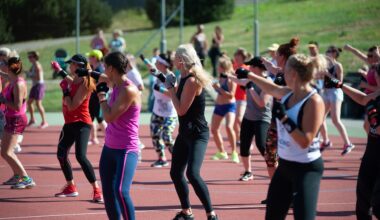The Role of Community Leadership in Environmental and Fitness Advocacy
Community leadership plays a vital role in advocating for environmental health and fitness, particularly within marginalized communities. These leaders possess a unique connection to the people and the area, enabling them to effectively communicate the significance of environmental justice and fitness awareness. They often take initiatives that educate residents about their surroundings and the importance of maintaining both physical and environmental health. For instance, community leaders may organize local workshops and seminars that highlight issues like pollution, waste management, and clean energy. Engaging community members in these initiatives fosters a sense of ownership and responsibility towards maintaining a healthy environment. Furthermore, leaders can galvanize resources, establish partnerships with local organizations, and harness funding opportunities to enhance community programs. They also serve as liaisons between residents and governmental or environmental agencies, ensuring that the community’s voice is heard. In addition, promoting accessible fitness activities through local parks or community centers encourages residents to adopt healthier lifestyles while fostering community bonds. By integrating fitness advocacy within broader environmental justice movements, community leaders can create sustainable change.
Successful community leaders often combine their knowledge of environmental issues with practical fitness initiatives, enhancing both areas. They recognize that health disparities often correlate with environmental injustices that can affect neighborhoods. These leaders focus on providing equitable access to community resources, such as parks and recreational facilities, that encourage physical activity. They can organize fitness programs specifically designed to address the needs of underrepresented populations, ensuring that everyone has the opportunity to partake and benefit. By implementing programs like community clean-up days, they can simultaneously address the physical environment and promote communal exercise. Moreover, these leaders can collaborate with local health organizations and nonprofits to promote wellness programs tailored to specific health concerns prevalent in their community. Such initiatives can lead to improved public health outcomes, reduced healthcare costs, and heightened community engagement. Active community participation not only strengthens social ties but also enhances individual and collective well-being. Ultimately, community leadership in environmental and fitness advocacy creates a synergistic effect that empowers people and promotes resilience, ensuring a healthier future for generations to come.
In the context of fitness advocacy, community leaders are increasingly vital for addressing public health challenges. They play a key role in developing programs designed to mitigate health issues such as obesity, diabetes, and other related ailments that can stem from environmental factors. This could involve advocating for more green spaces, walking paths, or safe areas for children to play, directly impacting the population’s fitness levels. Community functions that promote exercise naturally draw individuals together, fostering relationships and collective well-being. Furthermore, these events often serve as a platform to educate residents about the interconnectedness of their environment and health. Community gatherings can include workshops led by health professionals who explain how pollution affects local health trends and how fitness can be a positive coping mechanism. Initiatives that include fitness classes in urban parks or group activities promote physical engagement while raising awareness about environmental concerns. Equally important is celebrating community achievements that arise from these endeavors, reinforcing the value of sustained commitment to environmental fitness and preventative health measures.
Integrating Health and Environmental Education
Community leaders are pivotal in integrating health education with environmental stewardship, developing the requisite consciousness for solid change. This integration ensures that community members understand the direct impact of their surroundings on their health outcomes. For example, leaders can host educational sessions that cover topics such as the benefits of organic gardening, the importance of reducing waste, and the risks associated with environmental toxins. Such knowledge equips residents with the understanding necessary to engage proactively with their environment and adopt healthier lifestyles. By creating hands-on learning experiences, like community gardens that highlight sustainable practices, leaders can not only foster better eating habits but also combat environmental degradation. These initiatives instill values of sustainability and health that can influence behavior change. In collaboration with schools and local governments, community leaders can also advocate for policies that promote eco-friendly practices. This might involve pushing for healthier school lunches or ensuring that playgrounds remain safe and accessible for children. Community leaders act as catalysts, amplifying the community’s voice and translating knowledge into actionable strategies that enhance both health and environmental awareness.
Furthermore, community leadership in environmental and fitness advocacy presents an opportunity for social justice. Addressing inequities that exist within various communities requires a collective effort and informed advocacy. Leaders highlight how less affluent neighborhoods often lack access to quality recreational facilities or green spaces while being more susceptible to environmental hazards. They can work with local governments to create equitable policies that distribute resources fairly, leading to healthier, more active populations. By advocating for zoning changes that favor the addition of recreational areas or community centers, leaders contribute to the overall betterment of their neighborhoods. Additional access to these facilities is crucial for promoting physical health and community engagement. Through public forums and discussions, leaders can facilitate conversations around these issues, amplifying community concerns and driving change. Ultimately, strengthening community resilience against environmental challenges not only uplifts individual health but also reinforces the connection between environmental justice and fitness. These efforts pave the way for healthier, equitable communities where all individuals can thrive and live fulfilling lives.
Building Collaborations for Lasting Change
Successful community advocacy often involves building collaborations between various stakeholders. Local businesses, health organizations, and educational institutions can play significant roles in supporting local fitness and environmental initiatives. Community leaders can forge partnerships with these entities to pool resources, share knowledge, and expand outreach efforts. For example, collaborations can result in fitness programs sponsored by local businesses, incentivizing healthier habits while also boosting the economy. Schools can serve as venues for fitness programs that leverage students’ involvement in community projects, instilling values of environmental stewardship early on. Moreover, collaboration with healthcare providers ensures that community members receive valuable health information directly from professionals committed to improving their well-being. By creating a united front, community leaders can enhance their advocacy efforts, making a greater impact on public health and environmental conditions. These collaborations can also lead to innovative solutions to community challenges, such as joint initiatives that address both pollution reduction and the promotion of active lifestyles. By adopting a multifaceted approach that leverages community strengths, lasting change becomes achievable.
The journey toward effective community leadership in environmental and fitness advocacy is ongoing and requires dedication. Community leaders must remain informed about emerging trends related to environmental health and public wellness, adapting their strategies accordingly. Continuous learning and networking with other leaders across the nation provide valuable insights to enhance local efforts. Engaging with community members regularly ensures that advocacy remains relevant and rooted in the specific needs and desires of residents. Furthermore, the use of digital platforms and social media can amplify outreach efforts, promoting community advocacy to broader audiences. Sharing success stories and best practices not only inspires residents but can encourage neighboring communities to adopt similar initiatives. Funding opportunities may also be pursued, ensuring that programs can sustain themselves and evolve. In addition, communities can benefit from recognizing the interdependencies that exist between environmental issues and public health, reinforcing their advocacy approach. With resilience, adaptability, and compassion for the community, leaders play a transformative role in fostering an environment where health and fitness thrive alongside environmental sustainability. Their tireless efforts will resonate through generations, nurturing a legacy of social responsibility.
In concluding this discussion, recognizing the intrinsic link between environmental justice, community leadership, and fitness advocacy must prompt action from every stakeholder involved. Successful advocacy initiatives are built on a foundation of collaboration, education, and community engagement. As communities prioritize both environmental sustainability and individual health, they unlock a powerful synergy that fosters communal resilience. Community leaders serve as the driving force behind these efforts, empowering residents with the tools they need to advocate for themselves and their neighborhoods. Emphasizing inclusivity ensures that voices from every demographic are given space, forming a tapestry of support that benefits all community members. Consequently, collective action reflects broader environmental and health goals, securing a future that embraces justice and wellness. The role of community leadership is indeed critical, as the pursuit of environmental and fitness advocacy hinges on its success. With appropriate resources, commitment, and collaboration, communities can cultivate a culture of health that integrates environmental stewardship into daily practice. Thus, communities can thrive as they champion both personal and public health, ultimately leading to a healthier, more equitable world for all.


